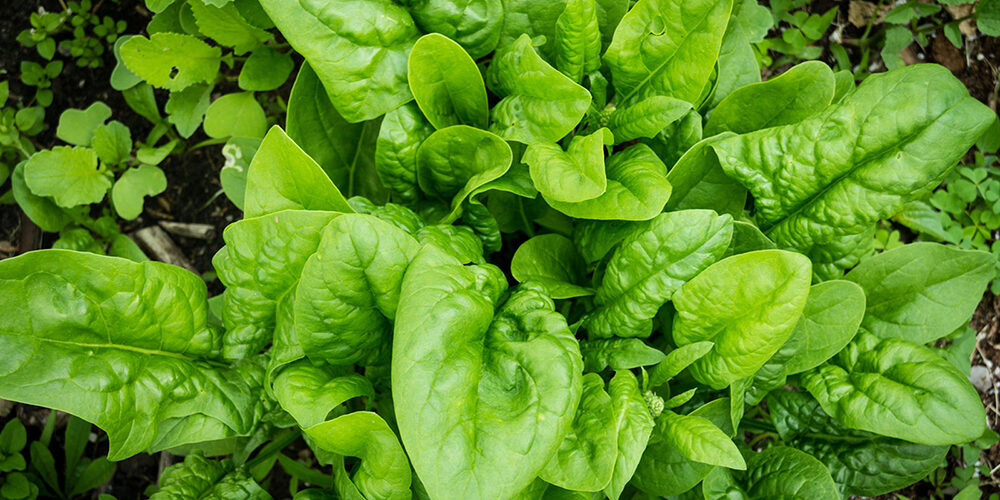Growing Spinach
Posted On April 4, 2020

Spinach, a super–cold-hardy leafy green, is a popular crop that can be planted in very early spring, as well as in fall and even winter in some areas.
Spinach has similar growing conditions and requirements as lettuce, but it is more versatile in both its nutrition and its ability to be eaten raw or cooked. It is higher in iron, calcium, and vitamins than most cultivated greens, and one of the best sources of vitamins A, B, and C. Learn more about its amazing benefits here.
See spinach and cheese sunshine pie recipe, or gnocchi with spinach and pepper sauce.
Planting
When to plant spinach
- Spring plantings can be made as soon as the soil can be properly worked. In order to give the required six weeks of cool weather from seeding to harvest, it’s important to seed as soon as you can.
- For proper germination, soil should not be warmer than 70ºF (21°C).
- Successive plantings should be made every two weeks during early spring.
- Gardeners in northern climates can harvest early-spring spinach if it’s planted just before the cold weather arrives in fall. Protect the young plants with a cold frame or thick mulch through the winter, then remove the protection when soil temperature in your area reaches 40ºF (5°F).
- Common spinach cannot grow in midsummer. (For a summer harvest, try New Zealand Spinach or Malabar Spinach, two similar leafy greens that are more heat tolerant.)
- If you live in a place with mild winters, you can also plant in the fall. Wait to plant until soil temps are cool enough.
Choosing and preparing a planting site
- Select a planting site with full sun (or partial sun, at least) and well-drained soil.
- Prepare the garden soil with aged manure about a week before planting, or, you may wish to prepare your spot in the fall so that you can sow the seeds outdoors in early spring as soon as the ground thaws. (Learn more about preparing soil for planting.)
How to plant spinach
- Although seeds can be started indoors, it is not recommended, as seedlings are difficult to transplant.
- Sow seeds ½-inch to 1-inch deep, covering lightly with soil. Sow about 12 seeds per foot of row, or sprinkle over a wide row or bed.
- Water the new seedlings well in the spring.
Care
How to grow spinach
- Fertilize only if necessary due to slow growth, or use as a supplement if your soil pH is inadequate.
- When seedlings sprout to about two inches, thin them to 3-4 inches apart.
- Beyond thinning, no cultivation is necessary. Roots are shallow and easily damaged.
- Keep soil moist with mulching.
- Water regularly.
- It can tolerate the cold; it can survive a frost and temps down to 15ºF (-9°C). (See local frost dates) Young spinach is more tender; cover if cold temps are in the forecast.
Pests/Diseases
- Leaf Miners: Radishes attract leaf miners away from spinach. The damage that the leaf miners do to radish leaves doesn’t prevent the radishes from growing underground.
- Bolting
- Mosaic Virus/Blight
- Downy Mildew
Harvest/Storage
How to harvest spinach
- Keep an eye on your plants. Harvest when leaves reach the desired size.
- Don’t wait too long to harvest or wait for larger leaves; bitterness will set in quickly after maturity.
- The whole plant can be harvested at once, and cut at the base, or leaves may be picked off plants one layer at a time, giving inner layers more time to develop.
Recommended Varieties
- ‘Giant Nobel’ is a plain leaf variety.
- ‘Winter Bloomsdale’ is a crinkled-leaf, fall variety, tolerant to mosaic viruses.
- ‘Tyee’ can be planted in spring or fall, and is resistant to downy mildew.
- Malabar Spinach (Basella alba) and New Zealand Spinach (Tetragonia tetragonoides) are two heat-tolerant leafy greens that are similar to common spinach. Grow them in the summer, when common spinach can’t take the heat.
Website: www.almanac.com
One Comment